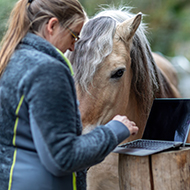Reindeer antlers could hold key to scarless healing

"This was really a breakthrough moment" - Professor Biernaskie.
A study on reindeer suggests that the species may hold the key to regenerative healing treatments for veterinary and human medicine, The Globe and Mail reports.
Published in Cell, the study explains the regeneration of reindeer antlers and explores the process as as a model to study skin regeneration.
Led by Professor Jeff Biernaskie, researchers used a series of surgical experiments to compare wounds on the skin of the antler, or 'velvet',
It was discovered that the velvet healed with no scar, but the back skin wound formed a raised non-pigmented scar, like in humans.
From this, researchers were able to identify a difference in the cellular processes, and found a cell type that is very different between the two sites – the fibroblast.
Professor Biernaskie told The Globe and Mail: “Deer are the only mammal that are able to regenerate an entire organ as an adult so that, in itself, is really fascinating.
“The other thing is that it grows at such an enormous rate. It got us thinking that maybe this would be a nice model to study skin regeneration.
“This was really a breakthrough moment in that we now had a model that in the same animal where we could now compare the molecular and cellular processes that underlie the regeneration of skin in one setting and then the scar formation in another.”
Discussing the regeneration process's potential to limit the severity of scarring or fully regenerate the skin, he continued: “We’re trying to modify that wound environment but also the injury response.
“The burn survivor is where we would really like to apply this knowledge.”
'Reindeer light the way to scarless wound healing' is published in Volume 15, Issue 25 of Cell.



 With Strangles Awareness Week just around the corner (5-11 May), vets are being encouraged to share a survey about the disease with their horse-owning clients.
With Strangles Awareness Week just around the corner (5-11 May), vets are being encouraged to share a survey about the disease with their horse-owning clients.